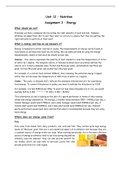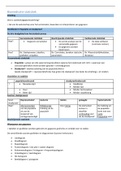Unit 12 – Nutrition
Assignment 2 – Energy
What should we eat?
Everyone can have a balanced diet by eating the right amounts of each nutrient. However,
athletes can adapt their diet to suit their sport or activity to ensure that they are getting the
right nutrients to perform at their best.
What is energy and how do we measure it?
Energy is measured in either calories or joules. The measurements of energy can be found on
food labels, so we know how much we are eating. We can make portions by using the energy
measurements, based on how much we should eat per day.
Calories – One calorie expresses the quantity of heat needed to raise the temperature of 1 litre
of water by 1 degree. The kilogram calorie, or kilocalorie (Kcal) more accurately defines the
calorie, so it is more commonly used. Protein has 4Kcal per gram, carbohydrate has 4Kcal per
gram, fat has 9Kcal per gram, and alcohol has 11Kcal per gram.
For example, if a certain food contains 300kcal, then releasing the potential energy trapped
within this, will increase the temperature of 300 litres of water by 1 degree.
Joules – The joule, or kilojoule (KJ), reflects the standard international unit for expressing
food energy. To convert kilocalories to joules, you need to multiply the kilocalorie by 4.184.
For example, rice has 365Kcal per 100g. To work out how many kilojoules are in rice, you would
multiply 365 by 4.184. 365 x 4.184 = 1527KJ
This information is vital in looking at the diet of a sports performer in terms of their energy
intake and energy expenditure. On average, a toddler needs between 1000 – 1400Kcal per day, a
female teenager would need 1700Kcal, and a male teenager would need 2000Kcal per day. A
female adult would need 2000Kcal, and a male adult would need 2500Kcal per day. However,
sports performers would need more calories than what is recommended because they are using
more energy.
Where does our energy come from?
Fats
Fats come from animal fats, dairy products, oils, nuts and fish. They contain quite high energy
levels, of 9Kcal per gram. Fats are a very beneficial aspect of an athlete’s diet because they are
a constant source of energy within our body. When working aerobically, fat is the most efficient
source of energy so athletes tend to use fats during long and low
intensity exercise sessions. They can also provide warmth for
our bodies, which can also help to lubricate joints Fats also
provide protection for vital organs.
, Proteins
Proteins come from animal sources such as meat, eggs and milk. They can also be found in beans
and seeds. They contain moderate energy levels, of 4Kcal per gram. Protein can provide energy
but are most often used for growth and repair of muscles, skin
and hair. This is beneficial to an athlete to help repair micro
tears in the muscle fibres after an exercise session, to help
build up muscle. They are only used for energy if there isn’t
enough carbohydrates or fats.
Carbohydrates
Carbohydrates come in two forms: simple, which come from sugars, so can be found in foods such
as sweets, chocolate and jam, as well as complex, which come from starches, such as pasta, bread
and potatoes. Simple carbohydrates tend to taste nice, but are not very nourishing, whereas
complex carbohydrates are very nourishing, and should form
the main part of meals and snacks. Eating complex
carbohydrates increases the muscle glycogen levels resulting in
reduced fatigue, and an improvement in performance at the end
of a competition.
For example, a marathon runner burns about 100 calories per mile. Therefore, if they trained for
the whole distance of the marathon, they would need an extra 2600 calories, on top of their daily
amount, which would be about 4500 calories a day for a female, and 5000 calories a day for a
male. 60-70% of their energy should come from carbohydrates, as this gives them slow release
energy, which can be stored in the muscles as glycogen, and used when they need it. About 15%
of their energy should come from protein, so that their muscles can grow and repair, and 10-15%
of energy should come from fat, as this is fast release energy, so could be eaten before running.
Unused fat could then be stored as glycogen in the liver and muscles as a reserve store of energy.
If this diet was not followed, the runners could become tired easily, and not have enough energy.
How can we monitor energy intake vs expenditure?
Body composition – This is the percentage of body weight, which is fat, water, muscle and bone.
It helps sports people to know if the ratio of their body components are right for their sport.
There are three main somatotypes, which are body types used to describe body composition.
Everyone can tend towards a somatotype, but most people are a mix of more than one.













